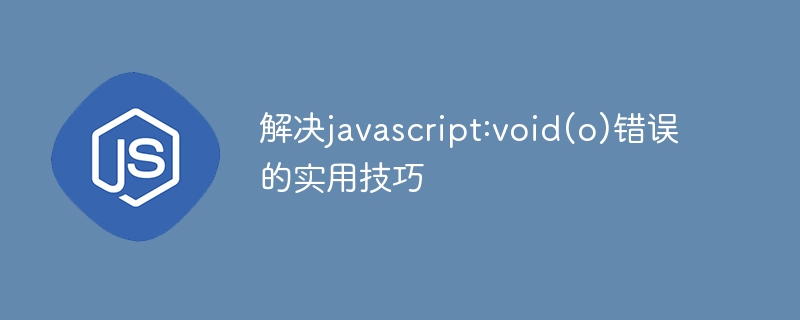
The "javascript:void(0)" error occurs when passing a function name as a string because the JavaScript engine interprets it as a statement instead of a function name. Fix tips include: 1. Use Template Literals; 2. Use arrow functions; 3. Use the bind() method. These methods allow you to avoid errors when passing function names.

Practical tips for solving "javascript:void(0)" errors in JavaScript
"javascript:void(0) " error is a common JavaScript error that occurs when trying to pass a function name as a string. This is often caused by oversights in handling user input in JavaScript code.
Why does this error occur?
When you use the "javascript:void(0)" string as part of JavaScript code, the engine interprets it as a statement rather than a function name. Therefore, it throws "javascript:void(0)" error.
Practical tips to fix this error:
1. Use Template Literals:
Template literals (template strings) Allows you to embed expressions in strings more easily. Surround strings with backticks (`) and embed function calls within ${}.
// 错误示例
document.addEventListener("click", javascript:void(0));
// 使用 Template Literals 的正确示例
document.addEventListener("click", `${eventHandlerFunction}`);2. Use Arrow Functions:
Arrow functions are a simplified function syntax that combines the declaration and expression of anonymous functions into one line. You can use arrow functions to pass the function name to a string.
// 错误示例
document.addEventListener("click", javascript:void(0));
// 使用箭头函数的正确示例
document.addEventListener("click", () => eventHandlerFunction());3. Use the bind() method: The
bind() method creates a new instance of a function in which the this keyword is bound to the specified object. You can use this to create event handlers that can call functions with different this values.
// 错误示例
document.getElementById("button").addEventListener("click", javascript:void(0));
// 使用 bind() 方法的正确示例
document.getElementById("button").addEventListener("click", eventHandlerFunction.bind(this));Practical case:
The following is a practical case of using Template Literals to fix errors:
<html>
<body>
<button id="my-button">Click me</button>
<script>
document.getElementById("my-button").addEventListener("click", `${eventHandlerFunction}`);
function eventHandlerFunction() {
console.log("Button clicked!");
}
</script>
</body>
</html>Note:
The above is the detailed content of Practical tips for solving javascript:void(o) errors. For more information, please follow other related articles on the PHP Chinese website!
 How to solve 0xc000409 error
How to solve 0xc000409 error
 How to solve the WerFault.exe application error
How to solve the WerFault.exe application error
 How to open two WeChat accounts on Huawei mobile phone
How to open two WeChat accounts on Huawei mobile phone
 nth-child
nth-child
 The difference between PD fast charging and general fast charging
The difference between PD fast charging and general fast charging
 Why can't I delete the last blank page in word?
Why can't I delete the last blank page in word?
 What are the attributes of a tag?
What are the attributes of a tag?
 How to open ramdisk
How to open ramdisk




